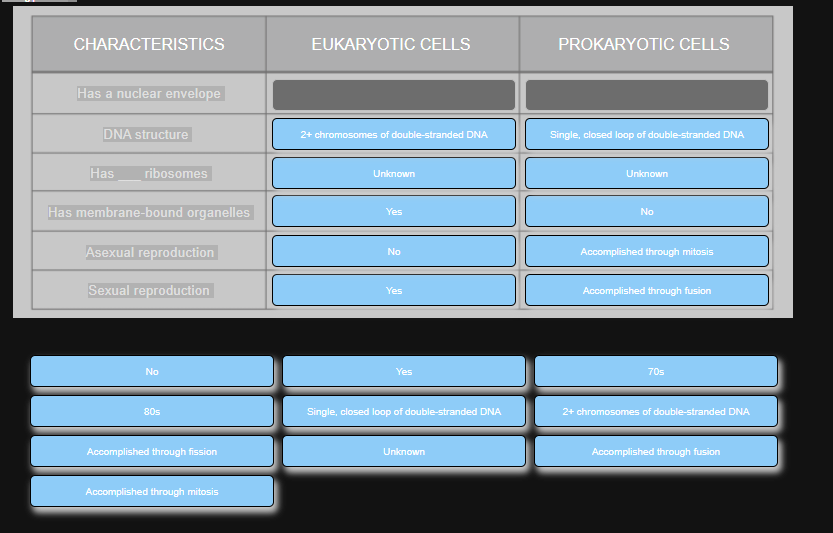CHARACTERISTICS EUKARYOTIC CELLS PROKARYOTIC CELLS Has a nuclear envelope DNA structure 2+ chromosomes of double-stranded DNA Single, closed loop of double-stranded DNA Has ribosomes Unknown Unknown as membrane-bound organelles Yes No Asexual reproduction No Accomplished through mitosis Sexual reproduction Accomplished through fusion Yes No Yes 70s 80s Single, closed loop of double-stranded DNA 2+ chromosomes of double-stranded DN Accomplished through fission Unknown Accomplished through fusion Accomplished through mitosis
CHARACTERISTICS EUKARYOTIC CELLS PROKARYOTIC CELLS Has a nuclear envelope DNA structure 2+ chromosomes of double-stranded DNA Single, closed loop of double-stranded DNA Has ribosomes Unknown Unknown as membrane-bound organelles Yes No Asexual reproduction No Accomplished through mitosis Sexual reproduction Accomplished through fusion Yes No Yes 70s 80s Single, closed loop of double-stranded DNA 2+ chromosomes of double-stranded DN Accomplished through fission Unknown Accomplished through fusion Accomplished through mitosis
Biochemistry
6th Edition
ISBN:9781305577206
Author:Reginald H. Garrett, Charles M. Grisham
Publisher:Reginald H. Garrett, Charles M. Grisham
Chapter28: Dna Metabolism: Replication, Recombination, And Repair
Section: Chapter Questions
Problem 19P: Figure 28.11 depicts the eukaryotic cell cycle. Many cell types “exit� the cell cycle and...
Related questions
Question
Not sure which is which

Transcribed Image Text:CHARACTERISTICS
EUKARYOTIC CELLS
PROKARYOTIC CELLS
Has a nuclear envelope
DNA structure
2+ chromosomes of double-stranded DNA
Single, closed loop of double-stranded DNA
Has
ribosomes
Unknown
Unknown
Has membrane-bound organelles
Yes
No
Asexual reproduction
Accomplished through mitosis
No
Sexual reproduction
Yes
Accomplished through fusion
No
Yes
70s
80s
Single, closed loop of double-stranded DNA
2+ chromosomes of double-stranded DNA
Accomplished through fission
Unknown
Accomplished through fusion
Accomplished through mitosis
Expert Solution
Step 1
Prokaryotic DNA is double-stranded circular DNA that is dispersed in the nucleoid, a dense area of cytoplasm. In prokaryotes, the DNA is not surrounded by a nuclear membrane. A single chromosome is represented by a single circular DNA strand. Because there are no histone proteins in this DNA, it is not a supercoiled shape like that found in eukaryotes. They use nucleoid-associated proteins to create loops. Prokaryotic DNA is commonly referred to as "bare DNA" since it lacks the histone framework. In eukaryotes, DNA is found in the nucleus, which is surrounded by the nuclear membrane. It has a straight form.
Trending now
This is a popular solution!
Step by step
Solved in 2 steps

Knowledge Booster
Learn more about
Need a deep-dive on the concept behind this application? Look no further. Learn more about this topic, biology and related others by exploring similar questions and additional content below.Recommended textbooks for you

Biochemistry
Biochemistry
ISBN:
9781305577206
Author:
Reginald H. Garrett, Charles M. Grisham
Publisher:
Cengage Learning

Anatomy & Physiology
Biology
ISBN:
9781938168130
Author:
Kelly A. Young, James A. Wise, Peter DeSaix, Dean H. Kruse, Brandon Poe, Eddie Johnson, Jody E. Johnson, Oksana Korol, J. Gordon Betts, Mark Womble
Publisher:
OpenStax College

Biology 2e
Biology
ISBN:
9781947172517
Author:
Matthew Douglas, Jung Choi, Mary Ann Clark
Publisher:
OpenStax

Biochemistry
Biochemistry
ISBN:
9781305577206
Author:
Reginald H. Garrett, Charles M. Grisham
Publisher:
Cengage Learning

Anatomy & Physiology
Biology
ISBN:
9781938168130
Author:
Kelly A. Young, James A. Wise, Peter DeSaix, Dean H. Kruse, Brandon Poe, Eddie Johnson, Jody E. Johnson, Oksana Korol, J. Gordon Betts, Mark Womble
Publisher:
OpenStax College

Biology 2e
Biology
ISBN:
9781947172517
Author:
Matthew Douglas, Jung Choi, Mary Ann Clark
Publisher:
OpenStax

Biology: The Unity and Diversity of Life (MindTap…
Biology
ISBN:
9781337408332
Author:
Cecie Starr, Ralph Taggart, Christine Evers, Lisa Starr
Publisher:
Cengage Learning